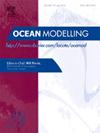Neural emulator based on physical fields for accelerating the simulation of surface chlorophyll in an Earth System Model
IF 2.9
3区 地球科学
Q2 METEOROLOGY & ATMOSPHERIC SCIENCES
引用次数: 0
Abstract
Simulating the ocean biogeochemical module (BGC-enabled) in the Community Earth System Model (CESM) is computationally expensive, often requiring significantly more resources than the physical climate component. In this study, we propose an alternative approach to generate biogeochemical data using a neural network emulator, BGC-UNet, which predicts ocean surface chlorophyll concentrations based on physical fields from CESM, such as solar short-wave heat flux (SHF-QSW), potential temperature (TEMP), and zonal and meridional velocity (UVEL, VVEL). BGC-UNet is designed as a UNet-like architecture and employs a patch-based methodology with dilated sampling to efficiently reconstruct biogeochemical data from physical inputs. This framework potentially enables high-resolution chlorophyll predictions without running full BGC-enabled simulations. Our evaluation demonstrates that BGC-UNet’s outputs closely align with CESM’s simulated surface chlorophyll, supported by both quantitative metrics and visual analysis. Additionally, the emulator achieves a simulation speed approximately 248 times faster than traditional BGC-enabled CESM simulations. Although the current focus is on surface chlorophyll, the model shows potential for future extension to other biogeochemical variables. By leveraging only 40 years of simulated data for training, BGC-UNet replicates the trends observed in CESM, making it a promising tool for accelerating Earth system modeling.
基于物理场的加速模拟地球系统模型中地表叶绿素的神经仿真器
在社区地球系统模型(CESM)中模拟海洋生物地球化学模块(BGC-enabled)的计算成本很高,通常需要比物理气候组件多得多的资源。在这项研究中,我们提出了一种利用神经网络模拟器BGC-UNet生成生物地球化学数据的替代方法,该方法基于来自CESM的物理场,如太阳短波热通量(SHF-QSW)、势温(TEMP)和纬向和经向速度(UVEL, VVEL)来预测海洋表面叶绿素浓度。BGC-UNet被设计为类似unet的架构,并采用基于补丁的方法和扩展采样,从物理输入中有效地重建生物地球化学数据。该框架有可能实现高分辨率叶绿素预测,而无需运行完全支持bgc的模拟。我们的评估表明,在定量指标和视觉分析的支持下,BGC-UNet的输出与CESM的模拟表面叶绿素密切一致。此外,仿真器的仿真速度比传统的BGC-enabled CESM仿真快约248倍。虽然目前的重点是表面叶绿素,但该模型显示了未来扩展到其他生物地球化学变量的潜力。通过仅利用40年的模拟数据进行训练,BGC-UNet复制了CESM中观察到的趋势,使其成为加速地球系统建模的有前途的工具。
本文章由计算机程序翻译,如有差异,请以英文原文为准。
求助全文
约1分钟内获得全文
求助全文
来源期刊

Ocean Modelling
地学-海洋学
CiteScore
5.50
自引率
9.40%
发文量
86
审稿时长
19.6 weeks
期刊介绍:
The main objective of Ocean Modelling is to provide rapid communication between those interested in ocean modelling, whether through direct observation, or through analytical, numerical or laboratory models, and including interactions between physical and biogeochemical or biological phenomena. Because of the intimate links between ocean and atmosphere, involvement of scientists interested in influences of either medium on the other is welcome. The journal has a wide scope and includes ocean-atmosphere interaction in various forms as well as pure ocean results. In addition to primary peer-reviewed papers, the journal provides review papers, preliminary communications, and discussions.
 求助内容:
求助内容: 应助结果提醒方式:
应助结果提醒方式:


